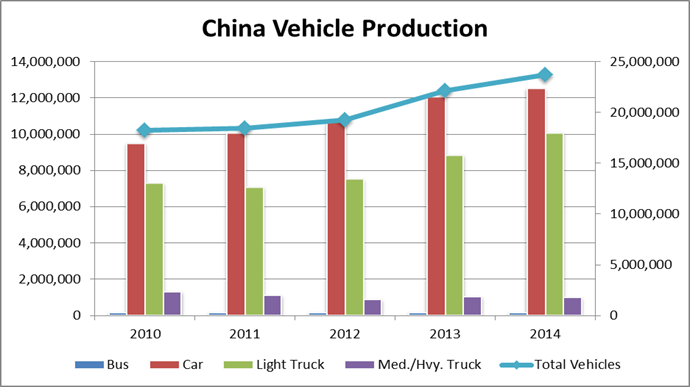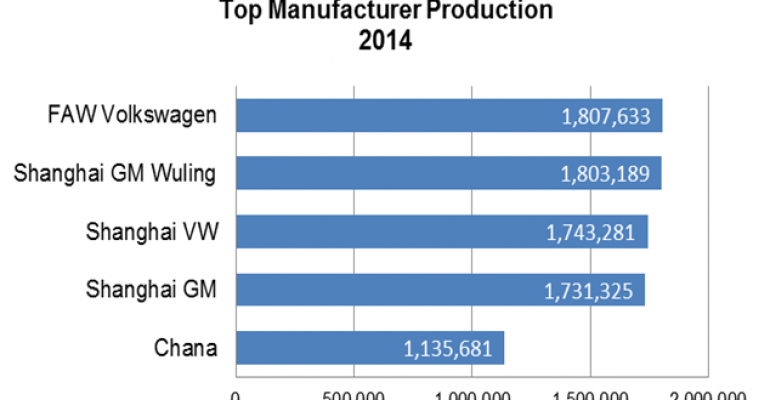Chinese automakers built a record 23.7 million vehicles in 2014, an increase of 7.3% from 2013’s 22.1 million-unit tally.
Although the industry finished the year on a high note with December output totaling just shy of 2.3 million units, also a record, 2014’s growth was significantly less than the 14.8% increase witnessed in 2013.
In 2014, total car builds reached 12.5 million units, up 3.7% from year-ago, with a 52.7% share of production. Light-truck output increased as well in the year, passing the 10-million-unit mark for the first time with the help of the continuously booming SUV segment. Light trucks also posted the largest year-over-year growth of any sector, up 13.9%. Medium/heavy trucks and buses tumbled in 2014, down 4.8% and 6.3%, respectively.
FAW-VW was the leading manufacturer in 2014 with 1.8 million builds, a 7.6% share of production. The manufacturer produced 519,504 units of its top model, the Volkswagen Jetta, and 306,284 units of the also popular Volkswagen Sagitar.
 SAIC-GM Wuling lagged just 4,500 units behind leader FAW-VW. The automaker’s top model, the Wuling Hongguang, was the highest volume model in 2014, with 775,220 units built.
SAIC-GM Wuling lagged just 4,500 units behind leader FAW-VW. The automaker’s top model, the Wuling Hongguang, was the highest volume model in 2014, with 775,220 units built.
With a 53.8% jump over year-ago, Beijing AIC witnessed the largest annual growth among the top 20 manufacturers. The automaker produced 553,444 vehicles in 2014, landing them in 15th place for the year. The introduction of the Huansu SUV and the C50E sedan increased total output by nearly 150,000 units, with the Huansu ending the year as the leading model for the manufacturer. Production of three more models are expected in 2015 as well, likely boosting the automaker in the rankings.
The slowdown in the auto industry’s growth rate came as the market neared maturity in some areas. Overcrowding, an ongoing issue in China, forced many local governments to restrict automobile ownership and traffic, and with more vehicles on the road each year in China, smog also has become an issue in larger cities.
The Chinese government has signaled that new energy vehicles (NEVs) are an important part of its strategy to deal with pollution. Several government initiatives such as providing funding to build electric-vehicle charging stations and exemption of NEVs from purchase taxes have encouraged automakers to increase production. Zotye’s Yun 100 EV and the BYD Denza EV launched output in November and December, respectively. Currently, NEVs only make up about 1% of total builds, but they are an indication of what’s to come in the future to address this serious issue for the Chinese Society.
While demand for new vehicles remains high in many smaller cities, and increased financing availability will allow more consumers to purchase vehicles, China’s market growth rate is not expected to return to the levels seen over the last decade.




